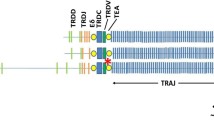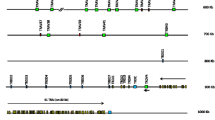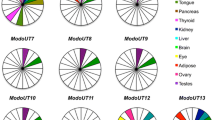Abstract
In sheep, the A and B loci encoding the α and β chains of the classical class II MHC molecules are DRA and DRB and DQA and DQB. Previous analyses described the duplication of the DQA and DQB genes. The majority of haplotypes include DQA1 and DQA2 loci, however, in a number of haplotypes, DQA1 appears absent and these haplotypes have been described as DQA1 null. In these haplotypes, the DQA2 locus is found in combination with a second locus which appeared more closely related to DQA2 than DQA1, hence the description of this locus as DQA2-like. Here we combine our previous analysis of the DQA transcripts with an analysis of the associated DQB transcripts in ten haplotypes from MHC homozygous animals. This allows the potential for surface expression of different haplotype combinations of DQA and B genes and the functional significance of DQA2-like and its predicted DQB partner to be determined. Atypical DQB transcripts (DQB2-like) were identified in haplotypes classified as DQA1-null and conserved DQB2-like orthologues were identified in other Bovidae indicating trans-species conservation of the allelic lineage. Functional combinations detected by co-transfection of DQ1, DQ2 and DQ2-like genes demonstrates the potential for a wide range of DQ molecules derived from both intra- and inter-haplotype as well as inter-locus combinations. We provide evidence that DQA2-like and B2-like genes form an evolutionary conserved pair which generates structurally distinct class II molecules that are likely to present a distinct range of peptides to CD4+ T cells.




Similar content being viewed by others
References
Ali AO, Stear A, Fairlie-Clarke K, Brujeni GN, Isa NM, Salisi MS, Donskow-Łysoniewska K, Groth D, Buitkamp J, Stear MJ (2017) The genetic architecture of the MHC class II region in British Texel sheep. Immunogenetics 69:157–163
Arnold K, Bordoli L, Kopp J, Schwede T (2006) The SWISS-MODEL workspace: a web-based environment for protein structure homology modelling. Bioinformatics 22:195–201
Ballingall KT, Wright H, Redmond J, Dutia BM, Hopkins J, Lang J, Deverson EV, Howard JC, Puri N, Haig D (1992) Expression and characterization of ovine major histocompatibility complex class II (OLA-DR) genes. Anim Genet 23:347–359
Ballingall KT, Dutia BM, Hopkins J, Wright H (1995) Analysis of the fine specificities of sheep major histocompatibility complex class II-specific monoclonal antibodies using mouse L-cell transfectants. Anim Genet 26:79–84
Ballingall KT, Miltiadou D, Chai ZW, McLean K, Rocchi M, Yaga R, McKeever DJ (2008a) Genetic and proteomic analysis of the MHC class I repertoire from four ovine haplotypes. Immunogenetics 60:177–184
Ballingall KT, Fardoe K, McKeever DJ (2008b) Genomic organisation and allelic diversity within coding and non-coding regions of the Ovar-DRB1 locus. Immunogenetics 60:95–103
Ballingall KT, Tassi R (2010) Sequence-based genotyping of the sheep MHC class II DRB1 locus. Immunogenetics 62:31–39
Ballingall KT, Rocchi MS, McKeever DJ, Wright F (2010) Trans-species polymorphism and selection in the MHC class II DRA genes of domestic sheep. PLoS One 5:e11402
Ballingall KT, Steele P, Lantier I, Cotelli M, Todd H, Lopez G, Martin E, Lantier F (2015) An ancient inter-locus recombination increases class II MHC DQA diversity in sheep and other bovidae. Anim Genet 46:333–336
Biasini M, Bienert S, Waterhouse A, Arnold K, Studer G, Schmidt T, Florian Kiefer F, Cassarino TG, Bertoni M, Bordoli L, Schwede T (2014) SWISS-MODEL: modelling protein tertiary and quaternary structure using evolutionary information. Nuc Acid Res 42(Web Server issue):W252–W258. https://doi.org/10.1093/nar/gku340
Braunstein NS, Germain RN (1987) Allele-specific control of Ia molecule surface expression and conformation: implications for a general model of Ia structure-function relationships. Proc Natl Acad Sci U S A 84:2921–2925
Brown JH, Jardetzky TS, Gorga JC, Stern LJ, Urban RG, et al. (1993) Three-dimensional structure of the human class II histocompatibility antigen HLA-DR1. Nature 364:33–39
Ellis SA, Holmes EC, Staines KA, Smith KB, Stear MJ, McKeever DJ, MacHugh ND, Morrison WI (1999) Variation in the number of expressed MHC genes in different cattle class I haplotypes. Immunogenetics 50:319–328
Fabb SA, Maddox JF, Gogolin-Ewens KJ, Baker L, Wu MJ, Brandon MR (1993) Isolation, characterization and evolution of ovine major histocompatibility complex class II DRA and DQA genes. Anim Genet 24:249–255
Forrest RH, Zhou H, Fang Q, Smyth A, Frampton CM, Hickford JG (2010) No evidence for a universal association between variation in faecal egg count for a mixed field-challenge of gastrointestinal parasites and the presence of the Ovar-DQA1 null haplotype in sheep. Vet Immunol Immunopathol 135:303–305
Gao J, Liu K, Liu H, Blair HT, Li G, Chen C, Tan P, Ma RZ (2010) A complete DNA sequence map of the ovine major histocompatibility complex. BMC Genomics 11:466. https://doi.org/10.1186/1471-2164-11-466
Grain F, Nain MC, Labonne MP, Lantier F, Lechopier P, Gebuhrer L, Asso J, Maddox J, Betuel H (1993) Restriction fragment length polymorphism of DQB and DRB class II genes of the ovine major histocompatibility complex. Anim Genet 24:377–384
Hasegawa M, Kishino H, Yano T (1985) Dating of human-ape splitting by a molecular clock of mitochondrial DNA. J Mol Evol 22:160–174
Herrmann-Hoesing LM, White SN, Kappmeyer LS, Herndon DR, Knowles DP (2008) Genomic analysis of Ovis aries (Ovar) MHC class IIa loci. Immunogenetics 60:167–176
Hickford JGH, Zhou H, Slow S, Fang Q (2004) Diversity of the ovine DQA2 gene. J Anim Sci 82:1553–1563
Hickford JGH, Zhou H, Fang Q (2007) Haplotype analysis of the DQA genes in sheep: evidence supporting recombination between the loci. J Anim Sci 85:577–582
Hopkins J, Dutia BM, McConnell I (1986) Monoclonal antibodies to sheep lymphocytes. I. Identification of MHC class II molecules on lymphoid tissue and changes in the level of class II expression on lymph-borne cells following antigen stimulation in vivo. Immunol 59:433–438
Kalyaanamoorthy S, Minh BQ, Wong TFK, von Haeseler A, Jermiin LS (2017) ModelFinder: fast model selection for accurate phylogenetic estimates. Nat Methods 14:587–589
Klein J (1987) Origin of major histocompatibility complex polymorphism: the trans-species hypothesis. Hum Immunol 19:155–162
Klein L, Kyewski B, Allen PM, Hogquist KA (2014) Positive and negative selection of the T cell repertoire: what thymocytes see (and don’t see). Nat Rev Immunol 14:377–391
Kimura M (1980) A simple method for estimating evolutionary rates of base substitutions through comparative studies of nucleotide sequences. J Mol Evol 16:111–120
Kwok WW, Kovats S, Thurtle P, Nepom GT (1993) HLA-DQ allelic polymorphisms constrain patterns of class II heterodimer formation. J Immunol 150:2263–2272
Marsh SGE, Albert ED, Bodmer WF, Bontrop RE, Dupont B, Erlich HA, Fernandez-Vina M, Geraghty DE, Holdsworth R, Hurley CK et al (2010) Nomenclature for factors of the HLA system, 2010. Tissue Antigens 75:291–455
Matthee CA, Davis SK (2001) Molecular insights into the evolution of the family Bovidae: a nuclear DNA perspective. Mol Biol Evol 18:1220–1230
Miltiadou D, Ballingall KT, Ellis SA, Russell GC, McKeever DJ (2005) Haplotype characterization of transcribed ovine major histocompatibility complex (MHC) class I genes. Immunogenetics 57:499–509
Minh BQ, Nguyen MAT, von Haeseler A (2013) Ultrafast approximation for phylogenetic bootstrap. Mol Biol Evol 30:1188–1195
Norimine J, Brown WC (2005) Intrahaplotype and interhaplotype pairing of bovine leukocyte antigen DQA and DQB molecules generate functional DQ molecules important for priming CD4+ T-lymphocyte responses. Immunogenetics 57:750–762
Parham P, Ohta T (1996) Population biology of antigen presentation by MHC class I molecules. Science 272:67–74
Petersen J, Kooy-Winkelaar Y, Loh KL, Tran M, van Bergen J, Koning F, Rossjohn J, Reid HH (2016) Diverse T cell receptor gene usage in HLA-DQ8-associated celiac disease converges into a consensus binding solution. Structure 24:1643–1657
Scott PC, Gogolin-Ewens KJ, Adams TE, Brandon MR (1991a) Nucleotide sequence, polymorphism and evolution of ovine MHC class II DQA genes. Immunogenetics 34:69–79
Scott PC, Maddox JF, Gogolin-Ewens KJ, Brandon MR (1991b) The nucleotide sequence and evolution of ovine MHC class II B genes: DQB and DRB. Immunogenetics 34:80–87
Scott PC, Choi C-L, Brandon MR (1987) Genetic organization of the ovine MHC class II region. Immunogenetics 25:116–122
Tamura K, Stecher G, Peterson D, Filipski A, Kumar S (2013) MEGA6: molecular evolutionary genetics analysis version 6.0. Mol Biol Evol 30:2725–2729
Trifinopoulos J, Nguyen L-T, von Haeseler A, Minh BQ (2016) W-IQ-TREE: a fast online phylogenetic tool for maximum likelihood analysis. Nucleic Acids Res 44:W232–W235
Trowsdale J (2011) The MHC, disease and selection. Immunol Lett 137:1–8
van Oorschot RA, Maddox JF, Adams LJ, Fabb SA (1994) Characterization and evolution of ovine MHC class II DQB sequence polymorphism. Anim Genet 25:417–424
Viginier B, Dolmazon C, Lantier I, Lantier F, Archer F, Leroux C, Terzian C (2012) Copy number variation and differential expression of a protective endogenous retrovirus in sheep. PLoS One 7:e41965
Wright H, Ballingall KT (1994) Mapping and characterization of the DQ subregion of the ovine MHC. Anim Genet 25:243–249
Acknowledgements
The support of the Bioservices Division at the Moredun Research Institute is gratefully acknowledged along with funding from the Scottish Government. The research leading to these results has also received funding from the European Community’s Seventh Framework Programme (FP7, 2007-2013), Research Infrastructures action, under the grant agreement No. FP7-228394 (NADIR).
Author information
Authors and Affiliations
Corresponding author
Electronic supplementary material
Supplementary Figure 1
Pair-wise alignment of DQB transcripts identified in this study along with all full-length sheep DQB transcripts available in GenBank. DQB1*02:01 and DQB2*04:01, EU176819; DQB1*08:01, XM_012173129 and DQB2-like*02:02 XM_012159546, both Mouflon, (Ovis aries musimon RefSeq Genome sequencing project); DQB1*05:01 (FJ985876). DQB2*07:01 (L08792). Representative cattle, (BoLA-DQB1, BC102959) and (BoLA-DQB, D37954), Buffalo, Bubalus bubalis, (Bubu-DQB, DQ908903) and Yak, Bos mutus (Bomu-DQB, XM_005909262). The translation initiation and termination codons are represented by ### and individual exons are labelled and sequentially shaded. Missing data and indels are represented by – . (DOCX 61 kb).
Rights and permissions
About this article
Cite this article
Ballingall, K.T., Lantier, I., Todd, H. et al. Structural and functional diversity arising from intra- and inter-haplotype combinations of duplicated DQA and B loci within the ovine MHC. Immunogenetics 70, 257–269 (2018). https://doi.org/10.1007/s00251-017-1029-z
Received:
Accepted:
Published:
Issue Date:
DOI: https://doi.org/10.1007/s00251-017-1029-z




